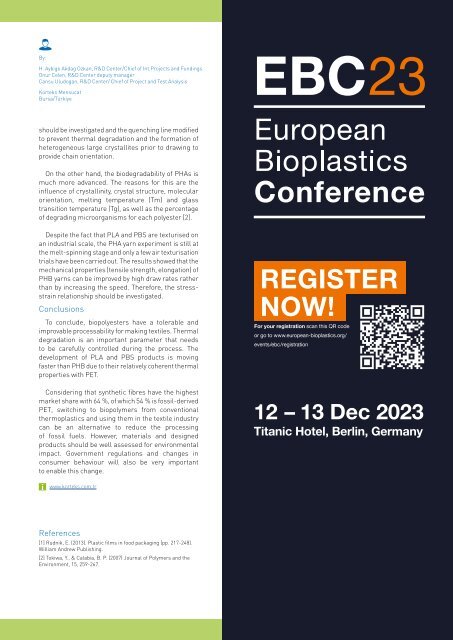Issue 05/2023
Highlights Fibres / Textiles Polyurethane / Elastomers
Highlights
Fibres / Textiles
Polyurethane / Elastomers
You also want an ePaper? Increase the reach of your titles
YUMPU automatically turns print PDFs into web optimized ePapers that Google loves.
By:<br />
H. Aybige Akdag Ozkan, R&D Center/Chief of Int.Projects and Fundings<br />
Onur Celen, R&D Center deputy manager<br />
Cansu Uludogan, R&D Center/ Chief of Project and Test Analysis<br />
Korteks Mensucat<br />
Bursa/Türkiye<br />
Category<br />
should be investigated and the quenching line modified<br />
to prevent thermal degradation and the formation of<br />
heterogeneous large crystallites prior to drawing to<br />
provide chain orientation.<br />
On the other hand, the biodegradability of PHAs is<br />
much more advanced. The reasons for this are the<br />
influence of crystallinity, crystal structure, molecular<br />
orientation, melting temperature (Tm) and glass<br />
transition temperature (Tg), as well as the percentage<br />
of degrading microorganisms for each polyester [2].<br />
Despite the fact that PLA and PBS are texturised on<br />
an industrial scale, the PHA yarn experiment is still at<br />
the melt-spinning stage and only a few air texturisation<br />
trials have been carried out. The results showed that the<br />
mechanical properties (tensile strength, elongation) of<br />
PHB yarns can be improved by high draw rates rather<br />
than by increasing the speed. Therefore, the stressstrain<br />
relationship should be investigated.<br />
Conclusions<br />
To conclude, biopolyesters have a tolerable and<br />
improvable processability for making textiles. Thermal<br />
degradation is an important parameter that needs<br />
to be carefully controlled during the process. The<br />
development of PLA and PBS products is moving<br />
faster than PHB due to their relatively coherent thermal<br />
properties with PET.<br />
Considering that synthetic fibres have the highest<br />
market share with 64 %, of which 54 % is fossil-derived<br />
PET, switching to biopolymers from conventional<br />
thermoplastics and using them in the textile industry<br />
can be an alternative to reduce the processing<br />
of fossil fuels. However, materials and designed<br />
products should be well assessed for environmental<br />
impact. Government regulations and changes in<br />
consumer behaviour will also be very important<br />
to enable this change.<br />
REGISTER<br />
NOW!<br />
For your registration scan this QR code<br />
or go to www.european-bioplastics.org/<br />
events/ebc/registration<br />
12 – 13 Dec <strong>2023</strong><br />
Titanic Hotel, Berlin, Germany<br />
www.korteks.com.tr<br />
References<br />
[1] Rudnik, E. (2013). Plastic films in food packaging (pp. 217-248).<br />
William Andrew Publishing.<br />
[2] Tokiwa, Y., & Calabia, B. P. (2007) Journal of Polymers and the<br />
Environment, 15, 259-267.<br />
bioplastics MAGAZINE | Renewable Carbon Plastics [<strong>05</strong>/23] Vol. 18<br />
29

















